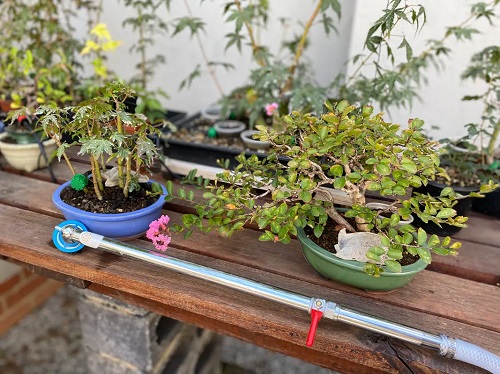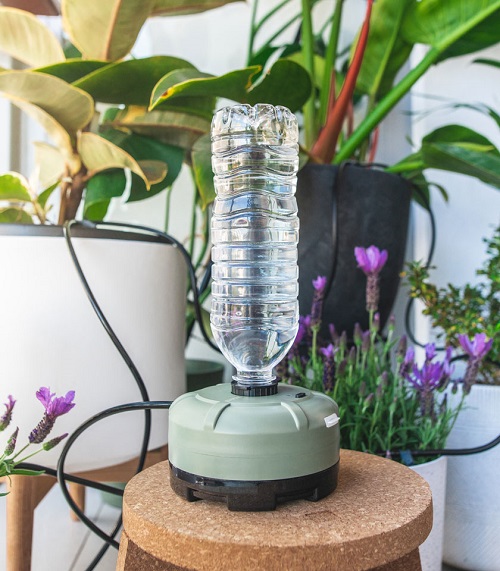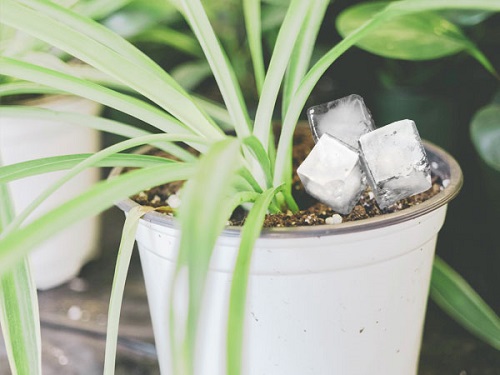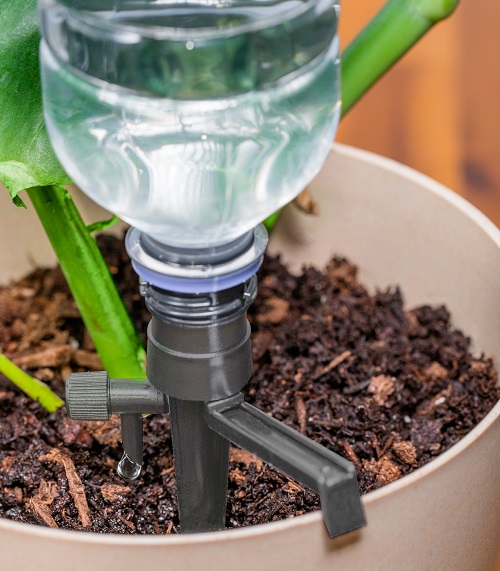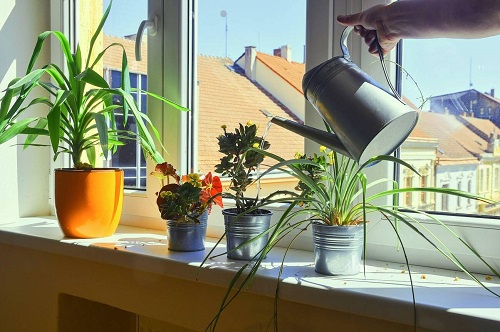Check out the best Indoor Plant Watering Tricks to Water So Many Plants in So little time with this expert guide.
Houseplants are a great way to bring a bit of nature into your home. However, watering them can be time-consuming, especially if you have many plants. Fortunately, there are tips and tools that can help you out! Check out some great Indoor Plant Watering Tricks below!
Follow 20 Easy DIY Watering Can Ideas You Can Make for Free
Indoor Plant Watering Tricks
1. Use a Watering Can with a Long Spout
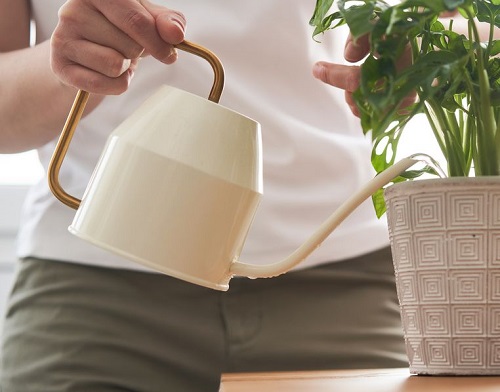
A watering can with a long spout can reach plants that are higher or farther away. It also helps to direct water to the soil and prevent splashing water all over the leaves.
This way, you can water plants quickly and effectively without making a mess.
2. Try a Watering Wand
A watering wand is a tool that attaches to a hose or a watering can and has a long, narrow tube with a showerhead at the end. This tool allows you to water plants more precisely, targeting the base of the plant without wetting the leaves.
It’s also perfect for watering hanging plants or plants on high shelves. However, this tool is much better for outdoor plants in your garden, patio, and balcony.
3. Self-Watering Pots
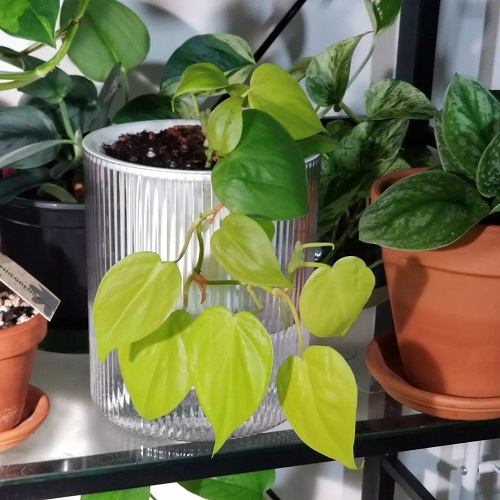
Self-watering pots are a great solution for people who tend to forget to water their plants regularly. These pots have a reservoir at the bottom that stores water, which is then slowly released into the soil as needed.
This means that you can water your plants less frequently while still ensuring they get the right amount of water.
Follow 18 DIY Watering Globe Ideas For Busy Gardeners here
4. Use a Drip Irrigation System
A drip irrigation is an automatic watering system that uses tubes or hoses with small holes to deliver water directly to the base of the plant. This system saves time and water, as it delivers water precisely where it’s needed and in the right amount.
You can also set it up with a timer, so you don’t have to worry about watering your plants while you’re away.
5. Water From the Bottom Up
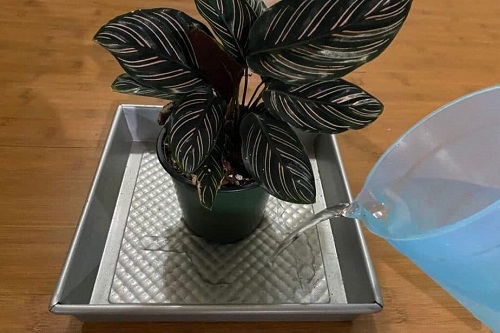
Watering from the bottom up is a great way to ensure that the roots get enough water without wetting the leaves. Simply place the plant in a tray of water and let it soak up the water through the drainage holes.
This method is especially useful for plants that are sensitive to getting their leaves wet, such as succulents.
6. Group your Plants Together

Grouping plants together can create a microclimate that helps to maintain humidity levels. This is especially useful for plants that require high humidity levels, such as ferns or tropical plants.
When you water one plant, the surrounding plants will also benefit from the increased humidity.
Grouping plants together that have similar watering needs also ensures you can water them together without overwatering or underwatering any specific plant in less time.
Check out 16 Clever Self-Watering Hacks here
7. Use a Spray Bottle
A spray bottle is a great tool for watering plants that need high humidity levels and misting, such as orchids, air plants, Boston fern, calathea, spider plant, ficus, philodendron, alocasia, fittonia, etc.
Simply fill a spray bottle with water and mist the plant as needed.
8. Ice Cubes
Ice cubes are a unique way to water your plants slowly and evenly. Simply place a few ice cubes on top of the soil and let them melt slowly.
This method is especially useful for plants that don’t like to be watered too much at once, such as peace lilies.
9. Use a Watering Spike
A watering spike is a tool that allows you to water your plants without having to be there. Simply fill a bottle with water, attach the watering spike to the top of the bottle, and insert the spike into the soil.
The water will slowly seep out of the bottle and into the soil, ensuring that your plant gets the water it needs.
Check out 18 DIY Drip Watering Systems for the Garden here
10. Pre-Fill Watering Cans
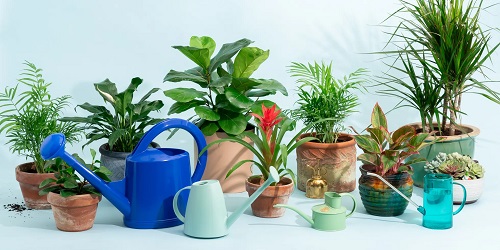
Pre-fill multiple watering cans or containers before you begin watering. This minimizes interruptions to refill, allowing you to move seamlessly from one plant to another.
Also, keep aside a watering can or bucket with a generous capacity when watering. This reduces the need for frequent refilling and enables you to cover more plants in one go.
11. Set Up a Rotating System
Divide your plants into groups and implement a rotating watering schedule. This prevents the need to water all plants in a single session and ensures even hydration over time.
By implementing these time-saving strategies, you can efficiently water multiple indoor plants without sacrificing their health and vitality. Streamlining your watering routine allows you to dedicate more time to enjoying your flourishing indoor garden.
Quick Points of Caution While Watering Indoor Plants
For Newbie Plant Parents
- Avoid Overwatering: Newbies often make the mistake of overwatering. This can lead to root rot, making your plant susceptible to diseases.
- Check Soil Moisture: Don’t just water on a set schedule. Instead, check the soil’s moisture level by sticking your finger an inch into the soil.
- Proper Drainage: Make sure your planters have drainage holes. Poor drainage can lead to water accumulation at the bottom, causing root rot.
- Use the Right Water: Tap water may contain chlorine or fluoride that could harm sensitive plants. Consider using filtered or distilled water.
- Temperature Matters: Avoid using cold water as it can shock the plants. Room temperature water is generally best.
DIY Container Water Garden Ideas For Container Gardeners
For Experienced Plant Parents
- Adjust Seasonally: Plants often need less water in winter. Adjust your watering schedule according to the season and current weather conditions.
- Watering Technique: Plants like orchids require special watering techniques like ‘soak and dry’. Familiarize yourself with plant-specific needs.
- Fertilizer Integration: While watering, consider when your plant needs nutrients. Over-fertilizing can lead to nutrient imbalances.
- Monitor for Diseases: Experienced plant owners should be on the lookout for diseases like mold and take immediate action, which may include adjusting watering habits.
- Know Your Plant: Each plant species has unique watering needs. Create a watering schedule that accommodates the diversity of your plant collection.
By understanding these watering fundamentals, both newbie and experienced plant parents can maintain healthier, happier indoor gardens.

